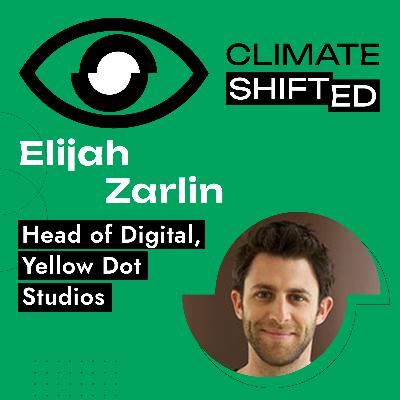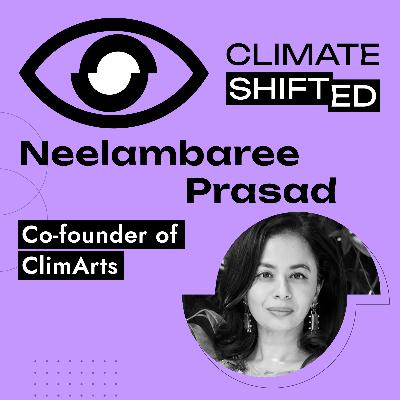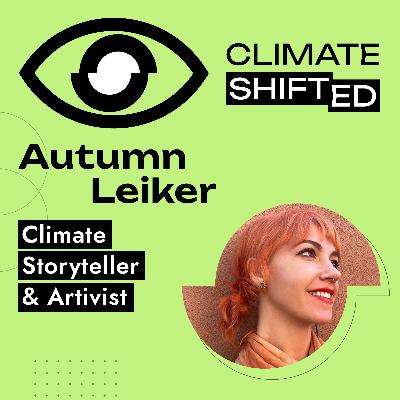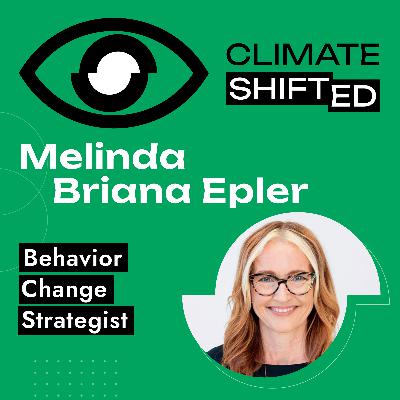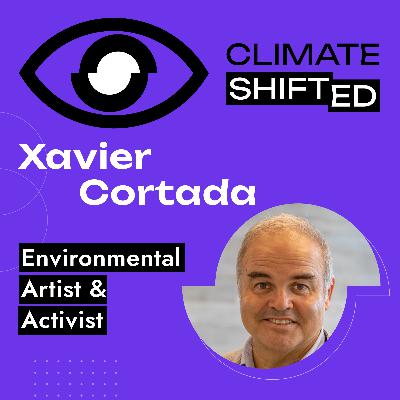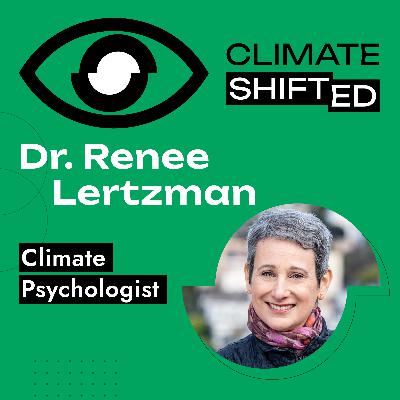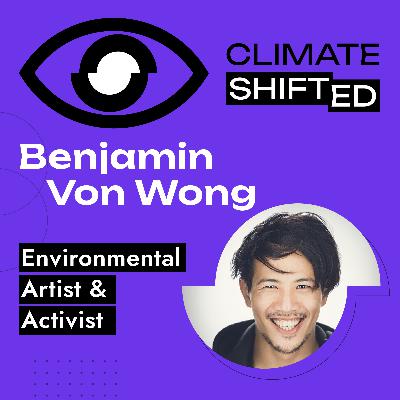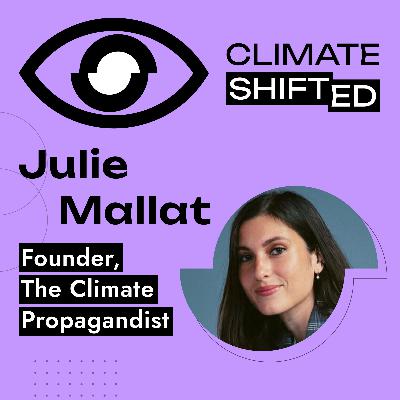Discover Climate Shifted
Climate Shifted

9 Episodes
Reverse
Episode Show Notes: S01E08 Culture Hacking with Elijah Zarlin from Yellow Dot Studios
Episode Description
In this season one finale of Climate Shifted, host Eva Frye speaks with Elijah Zarlin, Head of Digital and Engagement at Yellow Dot Studios—the climate film studio started by Adam McKay after his movie Don't Look Up with Leonardo DiCaprio, about a comet crashing down on Earth as a metaphor for the climate crisis. Elijah's journey from writing emails for Obama's 2008 campaign to getting arrested in front of the Obama White House protesting the Keystone XL Pipeline taught him a hard truth: even the most gifted communicators won't prioritize climate when fossil fuel narratives still dominate our culture.
Yellow Dot is proving that before we can change policy, we need to change the story people tell themselves about energy and who the real villains are. From viral Chevron spoof ads to the Gigaton Salon comedy shows featuring bumbling fossil fuel "executives," they're using the tools of creativity, celebrity, and comedy to expose, deconstruct, and deprogram decades of fossil fuel propaganda.
Discover why culture always comes before policy in social change movements, how to counter-program fossil fuel narratives with content that's more entertaining than the propaganda, and why making fossil fuels culturally embarrassing isn't just creative—it's strategic. Because when democracy and policy are this deeply broken, pulling the climate culture lever isn't optional, it's essential.
FULL TRANSCRIPT LIVES HERE.
Episode Details
Host: Eva Frye
Guest: Elijah Zarlin, Head of Digital and Engagement at Yellow Dot Studios
Season/Episode: S01E08 (Season One Finale)
Release Date: Nov 18, 2025
Duration: 36:49
Content Warning: Strong language in referenced content, bleeped
Key Topics Covered
Culture as the Last Lever for Change
How culture change precedes policy change in social movements
How fossil fuel companies have spent billions embedding narratives into our culture
The limitations of electing even gifted communicators when cultural narratives haven't shifted
Why pulling the culture lever is strategic when democracy and policy are broken
Historical parallels: Big Tobacco, drunk driving, marriage equality
Yellow Dot's Counter-Programming Strategy
The methodology: Expose, deconstruct, and deprogram fossil fuel narratives
Using creativity, celebrity, and comedy as tools for narrative warfare
Making fossil fuel greenwashing embarrassing to defend
Building cultural momentum until the green transition feels inevitable
Measuring impact through both viewing hours and audience attitude shifts
The Power of Entertainment in Climate Communication
Why entertainment doesn't just bypass defenses—it captivates and shifts values
How Don't Look Up + a 3-minute explainer increased climate understanding (Rare.org study)
The genius of making fossil fuels funny: normalizing climate action, not radicalism
Tapping into internet subcultures and celebrity fan communities for organic amplification
Simple direct-to-camera videos vs. expensive production: message matters most
Small Creator Playbook
Why the stories that travel farthest aren't necessarily expensive or sophisticated
Using strong language and strong emotions to create compelling content
Leveraging existing internet communities (comedy fans, gaming, show fandoms)
Helping people find their specific role in the climate movement
Meeting people where they are with diverse content formats
Fossil Fuel Propaganda We've Internalized
"Carbon footprint" (BP invented this to shift blame to individuals)
"Clean coal" (embedded through repetition)
"Energy scarcity" (myth—the sun produces unlimited energy)
"Sacrifice" (the real sacrifice is fossil fuels blocking renewable energy)
Why even climate communicators accidentally use fossil fuel frames
From Policy to Culture: Elijah's Journey
Starting at the bottom: door-to-door fundraising for the DNC in 2004
Working on Obama's 2008 campaign headquarters writing emails
The "clean coal" moment: questioning the messaging even while working to elect Obama
Getting arrested at the White House in 2012 as a former Obama staffer
Realizing leaders won't act without cultural pressure demanding it
Finding purpose in creative climate work: "Fighting as hard as I can"
Standout Quotes
"In this moment when policy and democracy are so deeply broken, culture is the one lever that we as individuals and we as creatives and storytellers, still really have."
"The goal of Yellow Dot is to expose and deconstruct and deprogram [Fossil Fuel propaganda] using the tools of creativity and celebrity and comedy or entertainment."
"The stuff that travels on social is not necessarily the stuff that's expensive. Use strong language and evoke strong emotions—it doesn't have to cost a lot of money."
"People say, oh, the science is complicated. It's really not that complicated…They just need to understand that there are fossil fuel executives who are intentionally murdering them and that it doesn't need to be that way. Stories need villains. And this story has villains."
"The fossil fuel industry has so much disinformation for so long that I see people buying into the frames of the fossil fuel industry all the time—like climate communicators, people on our side. Energy scarcity? That is a fossil fuel myth. The sun produces virtually unlimited energy."
"I was in front of the White House getting arrested, telling Obama to reject the Keystone XL Pipeline... It was a real wake up call about how far we need to come, how hard this is, and how hard we need to go."
"It's a battle... working with creative people who care and are just trying to make fun and funny and interesting things that speak to this moment... try like hell to break something loose. 'Cause that's all we can do."
Featured Resources & Organizations
Elijah's Work:
Yellow Dot Studios - yellowdotstudios.com
Elijah's LinkedIn - linkedin.com/in/elijahzarlin
Yellow Dot Instagram - @yellow.dot.studios
Elijah’s Instagram: @elijahion
Yellow Dot Content Referenced:
Chevron Spoof Ad - https://www.youtube.com/watch?v=BfeOWj6AsVc
Don't Look Up (Netflix) - Directed by Adam McKay, starring Leonardo DiCaprio
Gigaton Salon - Live comedy shows at climate events featuring fossil fuel "executive" parody
Let's Not Die - Comedy series
Sabotage Podcast - https://yellowdotstudios.com/sabotage/ (Top 10 on Apple Podcasts, deep dive with climate activists like Just Stop Oil)
The Try Guys climate content - https://yellowdotstudios.com/episode-1-the-try-guys/
Key People Referenced:
Adam McKay - Director of Don't Look Up, founder of Yellow Dot Studios
Leonardo DiCaprio - Star of Don't Look Up, created 3-minute climate explainer video
Tim Robinson - Comedian whose content reaches comedy fans who wouldn't watch traditional climate documentaries
Research & Reports Referenced:
Rare.org Study on Don't Look Up Impact - Showed significant increases in viewers' understanding of climate threats and willingness to support policy action when watching the film plus DiCaprio's 3-minute explainer
Project Drawdown Explorer - Eva's voiceover recommendation for checking legitimacy of climate solutions https://drawdown.org/explorer
Historical Social Change Parallels:
Big Tobacco "Truth Campaign" (2000) - Made tobacco industry look manipulative and uncool to teens
MADD & Designated Driver Campaigns (1980s-1990s) - Shifted drunk driving from "normal" to "irresponsible" through cultural messaging
Marriage Equality Media Representation (2000s-2015) - Will & Grace, Ellen, Modern Family changed hearts before policy shifted
Key Themes Explored
Culture Always Precedes Policy in Social Movements
Smoking became socially unacceptable before smoke-free laws passed with ease
Drunk driving cultural shift came before strict legal consequences
Marriage equality gained through personal stories and media representation
Policy fights can be reversed overnight; cultural shifts create lasting change
Yellow Dot's bet: Make fossil fuel greenwashing as unacceptable as smoking indoors
Systematic Counter-Programming vs. Counter-Messaging
Expose: Make the manipulation visible (Chevron spoof saying the quiet part out loud)
Deconstruct: Show HOW propaganda works
Deprogram: Offer something MORE entertaining than the propaganda
Goal isn't convincing every denier—it's making fossil fuel defense socially costly
When greenwashing becomes a punchline, it loses power
Entertainment as Strategic Weapon
Entertainment doesn't just educate—it captivates and shifts cultural values
Comedy makes fossil fuel talking points harder to take seriously
Celebrity platforms come with built-in audiences and trust
Internet subcultures amplify content organically (meme accounts, fan sites)
Simple, direct content with strong emotions travels further than expensive production
The Journey from Inside to Outside the System
Working within the system (Obama campaign) to demanding change from outside (protest)
Realizing gifted communicators are constrained by fossil fuel cultural dominance
Frustration as fuel for finding new levers to pull
Moving from policy pressure to culture change as primary strategy
Finding purpose in creative disruption rather than traditional advocacy
Fossil Fuel Frames We Need to Reject
"Carbon footprint" - Shifts blame to individuals (BP invention)
"Energy scarcity" - False; the sun produces unlimited energy
"Sacrifice" - Backwards; fossil fuels ARE the sacrifice blocking solutions
"It's complicated" - No; there are villains intentionally blocking progress
Even climate advocates accidentally reinforce these frames
Juicy Bits: Key Takeaways for Climate Communicators
There's no right way to do it - As long as you're being creative and entertaining, just try lots of things. Do what moves you and what seems to move other peop
In this episode of Climate Shifted, host Eva Frye speaks with Neelambaree Prasad, a pharmacologist and classical Indian dancer who refused to live a "split screen life." After becoming a mother during the pandemic and witnessing how climate change was the root cause of global health crises, Neelambaree co-founded ClimArts—a nonprofit that bridges the gap between climate scientists and artists to create stories that connect with both hearts and minds.
From ancient Indian temples that served as centers of learning through dance and music, to modern collaborations featuring ballet dancers personifying coral bleaching and comedians tackling air pollution, Neelambaree shows us why the future of climate communication isn't just better science or better art—it's the magic that happens when research meets emotional resonance.
Discover how to match scientific expertise with artistic expression, why "bounded imagination" keeps collaborations grounded, and the practical framework any organization can use to create climate stories that actually move audiences to action. Because when we combine data with dance, facts with feelings, we create something neither science nor art could achieve alone.
FULL TRANSCRIPT LIVES HERE.
Key Topics Covered
The Art-Science Gap in Climate Communication
Why technical climate messages push audiences away instead of drawing them in
How scientists and artists struggle to find meeting spaces for collaboration
The challenge of maintaining scientific accuracy while creating emotional connection
Moving beyond "doom and gloom" to solution-oriented storytelling
Ancient Wisdom for Modern Problems
How Indian temples historically served as centers of learning through art
The composite nature of classical Indian dance (music, theater, poetry, storytelling)
Applying traditional frameworks to contemporary climate challenges
The power of personification in connecting audiences to natural systems
ClimArts' Collaborative Framework
Building trust between scientists and artists through common goals
The concept of "bounded imagination" to maintain scientific integrity
Matching art forms to specific scientific messages and audiences
Managing the collaboration process from initial meeting to final product
Impact and Distribution Strategies
Creating docu-films for maximum reach and accessibility
Measuring both quantitative metrics and qualitative transformation stories
The "train the trainer" approach to amplifying impact through existing storytellers
Strategies for demonstrating value to funders in the arts-science space
Standout Quotes
"I always had this unrest in me about why my two worlds cannot converge."
"The pandemic had its root cause in climate change... And that's how ClimArts began."
"Science provides data and analysis and evidence while art accesses emotions and intuition, so together they create a more complete understanding of complex problems."
"It's not science alone that can do it. Not just policy that can do it, but there needs to be a cultural transformation, and that is where art comes in to change the narratives."
"We personified the river through our dance to convey that it's a sentient being."
"You cannot do it alone. That's the one big learning—you have to join forces... Collaboration, collaboration, collaboration is my learning."
"Who is this message for? No funder will accept the answer that my audience is the general public."
Featured Resources & Organizations
Neelambaree's Work:
ClimArts.org - Nonprofit connecting climate scientists with artists
ClimArts LinkedIn and Instagram
Neelambaree's LinkedIn
Resilient River - Dance piece about Indian rivers and flooding (featured on ClimArts website)
Key Collaborations & Partners:
Inside the Greenhouse, University of Colorado Boulder - Creative climate communication initiative led by Max Boykoff
Energy Change Institute at Oxford - Low carbon community transition theater project
English Youth Ballet - Coral bleaching ballet collaboration
Howard School of Public Health - Coral reef solutions partnership
Kings College London - Geography department (floods and droughts research)
School World Forum - Climate justice workshop venue
Key People Referenced:
Max Boykoff - Climate communications expert, author, and professor at CU Boulder; co-director of Inside the Greenhouse
Kripa Iyer - Co-founder of ClimArts, economist and dancer based in London
Dr. Daanish Mustafa - Kings College London geographer specializing in floods and droughts
Reports & Research Referenced
Climate Impact Studies:
Yale CBEY Net-Zero Report - References McKinsey climate analysis; notably focuses on land-based solutions with limited ocean emphasis
National Forests: Shifting Range - Forest migration patterns due to climate change
Scientific American: Greenland's Ice Sheet Collapse - Latest research on accelerating ice loss
Collaboration & Communication Frameworks:
Probable Futures: Bounded Imagination - Framework for keeping solutions grounded in what the science tells us
IDEO: Design Constraints - How limitations can enhance creative collaboration
Key Themes Explored
The Power of Personification
Making landscapes and natural systems feel like sentient beings
Drawing parallels between human experiences and environmental challenges
Moving beyond the trend to avoid anthropomorphizing nature
Rights of nature movements giving legal standing to ecosystems
Cultural Transformation Through Art
Why policy and science alone cannot drive necessary climate action
How art changes narratives and cultural understanding
The role of storytelling in making abstract concepts tangible and personal
Creating emotional openings that make audiences want to care and act
Collaborative Framework Design
Building trust through shared goals and clear role definition
Managing the tension between scientific accuracy and artistic expression
The importance of "bounded imagination" to maintain credibility
Intervening at key points to keep collaborations on track
Community-Centered Impact
Training existing storytellers rather than creating content for general audiences
Amplifying local voices and community-led solutions
Measuring transformation through both data and narrative
Creating sustainable funding models for arts-science collaborations
Juicy Bits: Key Takeaways for Climate Communicators
Know your specific audience - "General public" isn't an acceptable target. Create detailed personas including demographics, hopes, dreams, and challenges
Pick the right messenger - Ask yourself: Are you the most effective person to deliver this message? Should it be a subject matter expert or community voice instead?
Craft your message strategically - Once you know your audience and messenger, include: What's the problem? Why does it need solving? What's the proposed solution? End with hope or clear call to action
Embrace personification - Make natural systems feel like sentient beings to create emotional connection
Collaborate, don't work alone - The most impactful climate communication requires joining forces across disciplines
Use "bounded imagination" - Let artists think creatively while scientists ensure accuracy and nuance aren't lost
Create video content - Essential for reaching diverse audiences, especially post-pandemic
Focus on solutions - Move beyond doom and gloom to spotlight actionable pathways forward
Call to Action
Are you a scientist with a story burning inside, or an artist ready to ground your work in evidence? The climate crisis is too important for us to keep working in silos.
Support Neelambaree's Work:
Visit climarts.org to learn about collaboration opportunities
Follow @climarts_ on Instagram and LinkedIn for project updates
Apply to join their programs if you're an artist or expert
Consider philanthropic support—sponsors' names travel with films to festivals
Get Involved:
Share your favorite climate storytelling or art with @climateshifted on Instagram
Tell us why it moved you—we'll reshare our favorites
Consider becoming a paid substack subscriber for episode insight digests, and to help this volunteer-based team with a season 2!
Look for collaboration opportunities in your own community
Reach out to hi@climateshifted.com if you know of any grant or sponsorship opportunities that would be a good fit for us
Credits
Executive Producer & Host: Eva Frye
Technical Producer: Mateus Salgado
Audio Engineer: Gianna Scioletti
Project Management: Sarah Clayton
Social Media: Amanda Bauer, Ashley Chapman, Louise Lau
In this episode of Climate Shifted, host Eva Frye speaks with Autumn Leiker, a designer and climate artivist based in Santa Fe, New Mexico. While many climate stories are doom-and-gloom, Autumn decided to ask their community a different question: considering the realities of the climate crisis, what world do you actually want to live in? This simple but powerful question became Into the Unknown Together, a beautiful anthology of stories, recipes, and art from the people of New Mexico. This work is powerful because when we get out of the limiting fear mindset and into creative ideation, when we imagine the world we do want, we actually start to build it.
Autumn had never published a book or run a contest before—but they showed that any of us can create something meaningful in our own communities.
Discover why listening matters more than telling, how stories are humanity's most powerful tool for creating change, and the practical steps any of us can take to inspire climate imagination in our own communities. Because when we tell new stories about our climate future, we imagine the pathways for living into them.
FULL TRANSCRIPT HERE
Key Topics Covered
The Power of Place-Based, Community Storytelling
Why stories are humanity's tool for creating change and new worlds
How climate stories can move beyond apocalyptic doom to inspire imagination
Making abstract climate issues personally relevant through place-based narratives
The role of artists and storytellers as "new world midwives"
Building Climate Imagination
Moving from "what we don't want" to "what we do want" in climate futures
Why utopian thinking isn't the goal—complex, realistic visions are
Balancing grief and joy in climate work
Processing the full spectrum of climate emotions through creative expression
Community-Centered Approach
How Autumn approached their project as an anthropologist and listener
The importance of amplifying local voices rather than imposing outside ideas
Creating space for diverse perspectives and first-time contributors
Building projects that reflect the actual ecology and culture of a place
Practical Project Building
How to start a community storytelling project from scratch
Navigating grants, outreach, and building without institutional backing
The power of commissioning alongside open submissions
Making projects accessible and beautiful to draw people in
Standout Quotes
"We are the storytelling animal... Everything is a story that someone has imagined, so the world that we're living in today and all the systems that we are living in, for better or worse, they are all something that someone imagined at some point."
"When writers create new stories, they open up pathways that we can also live into... it is how we can create new worlds."
"If we don't try to start imagining what we do want and then how to get there, then it's never going to happen."
"Being on the right side of history doesn't necessarily mean we're going to make it... but I want to be on the right side of things, and I want to help others engage with that as well."
"I so want more people to do this. Please take the idea, do whatever you want with it, change it, do it in your communities."
Featured Resources
Autumn's Project:
Into the Unknown Together - Climate anthology for and by the people of New Mexico
Autumn's Portfolio - Design and climate storytelling work
Influences & Inspiration:
Adrienne Maree Brown - Visionary fiction author and activist who inspired the project
Jamie Figueroa's "Prophecies of Possibility" for Emergence Magazine
Anonymous Was A Woman Environmental Art Grant - Funded the project
Essential Reading Mentioned:
Ursula K. Le Guin - Science fiction author who explored creating new worlds and systems
Robin Wall Kimmerer - Blends science with indigenous wisdom (highly recommended in audiobook)
David Abrams - "The Spell of the Sensuous" on animism and written language
Norma Wong - Activist and community organizer
Organizations & Collaborators Mentioned
Emergence Magazine - Featured Jamie Figueroa's essay referenced in the book
Zoe Young - Writer and collaborator who keeps Autumn going in this work
Local New Mexico libraries - Recipients of free book copies
Community contributors - Over 100 submissions from local residents
Key Themes Explored
Grief and Joy as Climate Tools
How our capacity for joy maps directly to our ability to feel grief
Processing climate emotions without getting stuck in fear or bypassing to optimism
Creating space for the full spectrum of human experience in climate work
Place-Based Climate Action
Why local, ecological storytelling resonates more than abstract global messaging
Understanding your community before trying to create change
The importance of being "people of our ecologies" in climate adaptation
Creative Climate Communication
Listen before creating anything, and amplify local voices
Use beauty and curiosity to draw people into difficult conversations
Create accessible entry points through diverse formats (stories, recipes, art, poetry)
Juicy Bits: Key Takeaways for Climate Communicators
Listen first, create second - Spend time understanding your community before launching any project
You don't need permission - Autumn had no experience but started anyway and created something beautiful
Embrace emotional complexity - Hold space for grief, hope, anger, and joy simultaneously
Make it local and personal - Place-based storytelling works because it speaks to people's actual lives
Stories create pathways - When we imagine better futures, we make them more possible
Focus on what you want - Move from fighting against to building toward
Process matters as much as output - How you treat contributors becomes part of world-building
Call to Action
Which story or voice does your community need to hear? What world are you helping them imagine?
Support Autumn's Work:
Purchase "Into the Unknown Together" at intotheunknowntogether.com
Request a free copy for your community organization
Adapt their model for your own place-based storytelling project
Connect with Climate Shifted:
Subscribe wherever you listen to podcasts
Follow @climateshifted on all social media platforms
Share this episode with anyone interested in creative climate communication
Consider supporting our volunteer team through Substack for Episode Insight Digests
Credits
Executive Producer & Host: Eva Frye
Technical Producer: Mateus Salgado
Audio Engineer: Gianna Scioletti
Project Management: Sarah Clayton
Advisers: Ryan Shuken, Ashley Chapman, Chris Clark
In this episode of Climate Shifted, host Eva Frye speaks with Melinda Briana Epler, a TED Speaker and behavior change strategist who has worked on national programs with organizations like the American Hospital Association. Melinda is currently authoring a whitepaper on climate communication best practices called Our Moment is Now, out soon.
Discover why fear-based climate messaging burns people out, how to move audiences up Maslow's hierarchy of needs to create lasting change, and why listening might be the most powerful tool in a climate communicator's toolkit. Learn practical frameworks for designing user journeys that meet people where they are and guide them toward sustained climate action over time.
Full Transcript Found Here
Key Topics Covered
The Psychology of Climate Motivation
Why fear and guilt are unsustainable motivators for climate action
How to use Maslow's hierarchy of needs in climate communications
The importance of moving from fear-based messaging to love and joy
Building identity-based climate action for lasting change
Behavior Change Strategy
The "trim tab" approach: finding small actions that create big impact
Stages of change model: from unconcerned to maintaining action
Meeting people where they are vs. where you want them to be
Designing user journeys for long-term engagement
Communication Tactics That Work
The power of listening before speaking
Why storytelling beats abstract messaging
Building trust through community ambassadors
Moving from individual awareness to policy change
Bridging Political Divides
Whether to engage dismissive audiences or focus on the converted
Finding common ground across political differences
Learning from bipartisan policy successes
The role of trusted messengers in polarized times
Standout Quotes
"Often people want to just go right to the solution and jump into building awareness... But I would say you need to take a step back to really understand the problem that you're trying to solve."
"Fear is a common emotion that can be evoked by climate communications... And it's not a sustainable emotion. That's why climate anxiety is on the rise."
"If somebody identifies as somebody that takes climate action, they're much more open to taking other climate actions."
"The number one role in communications I would say is listening. First really understanding where people are coming from."
Featured Research & Resources
Melinda's Climate Communication Research:
Our Moment is Now: Best Practices in Climate Communication - Executive summary available now, full research paper coming soon
Featured Interview:
Nisha Anand on Bipartisan Climate Policy - CEO of Dream.org discusses building bridges across political divides
Key Frameworks Mentioned:
Stages of Change Model for behavior design
Maslow's Hierarchy of Needs for motivation
Yale's Six Americas climate audience segmentation
Community-based social marketing approaches
Organizations & People Mentioned
Dream.org - Nisha Anand's organization focused on bipartisan policy change
American Hospital Association - Partner on national energy efficiency program
Nature Conservancy - Example of nonpartisan environmental approach
Greenpeace - Contrasted as confrontational vs. collaborative approach
Dr. Katherine Hayhoe - Climate scientist and communication expert
Dr. Renee Lertzman - Environmental psychologist
George Marshall - Author of "Don't Even Think About It"
Brené Brown - Researcher on shame and vulnerability
Juicy Bits: Key Takeaways for Climate Communicators
Start with systems thinking - Find the "trim tab" - the smallest action that creates the biggest impact
Listen first, speak second - Understanding where people are now is more important than where you want them to be
Move beyond fear - Use fear only as an initial trigger, then transition to hope, love, and identity-based motivation
Design for the long term - Create user journeys that move people through stages of change over time
Find trusted messengers - Work with community ambassadors when your audience doesn't trust you directly
Seek common ground - Even dismissive audiences can be engaged when you find shared values
Measure what matters - Track behavior change, not just awareness metrics
Sustain yourself - Connect with what brings you joy to avoid burnout in this challenging work
Connect with Melinda
Website: melindabrianaepler.com
LinkedIn: Melinda Briana Epler
Instagram: @melindabrianaepler
Call to Action
Climate communication doesn't have to rely on fear and guilt. Download Melinda's executive summary on climate communication best practices and start designing behavior change campaigns that meet people where they are and guide them toward lasting action.
Subscribe to Climate Shifted wherever you listen to podcasts and follow @climateshifted on social media for more expert insights on what actually works to shift hearts and minds on climate.
In this episode of Climate Shifted, host Eva Frye speaks with Xavier Cortada, a socially engaged environmental artist and Florida Artist Hall of Fame member. He creates participatory art projects transforming how communities understand and respond to the climate crisis.
Xavier shares how his "Underwater Homeowners Association" project used lawn signs showing home elevation levels to make sea level rise personally relevant to inland residents, how he strategically uses art to invite curiosity rather than confrontation, and how he builds coalitions with local institutions to create lasting policy change.
Learn how his approach to "social practice art" sculpts people instead of clay, makes topics personal to bypass political polarization, and discover how anyone can get started doing projects like this in your own communities.
Transcript available here
Key Topics
Using "social practice art" to create community climate engagement
Making abstract climate threats personally relevant through art
Designing art experiences that invite curiosity rather than confrontation
Building strategic partnerships with municipalities, schools, and nonprofits
Creating platforms for civic engagement beyond awareness
Moving from individual action to policy change
Balancing different communication approaches for different audiences
Starting with personal passion rather than waiting for permission
Finding sustainable motivation through love rather than fear
Quotes
"Art allows you to see things differently, but it also allows you to behave differently. And you then model to those who aren't part of the process, how they too can do the same thing." - Xavier Cortada
"My way in was the yard sign. What's this weird number doing in my neighbor's front yard? And then that curiosity allows you to understand that you have a vulnerability, that it's not someone else's problem, it's your problem." - Xavier Cortada
"What I try to do is journey into this land called hope, and art gets us there." - Xavier Cortada
"At the end of the day I'm not trying to change human behavior. I'm trying to change the policies that allow corporate interests to exploit people and to extract from our environment." - Xavier Cortada
People & Organizations Mentioned
Xavier Cortada - Socially engaged environmental artist and Florida Artist Hall of Fame member
Underwater Homeowners Association - Community organization created through Cortada's art project
Cortada Foundation - Organization founded to scale Cortada's climate art approach
Natural Resources Defense Council - Environmental organization that partnered with Cortada on the Blake Plateau project
Joseph Beuys - Pioneering social practice artist mentioned as an influence
Notable Art Installations Discussed
Underwater Homeowners Association: A participatory art project where residents displayed signs showing their home's elevation above sea level, transforming abstract sea level rise data into personal concerns about property values and flood insurance.
Elevation Markers: Street paintings showing elevation levels at intersections throughout Miami, demonstrating how even areas miles inland were vulnerable to sea level rise.
Park Elevation Sculptures: Vague concrete sculptures with QR codes in parks that, when scanned, revealed the park's elevation and sea level rise projections.
Reclamation Project: An installation where mangrove seedlings were displayed in water-filled cups on retail storefronts throughout Miami Beach, revealing the area's history as a mangrove forest before development.
JUICY BITS: Takeaways for Climate Communicators
Believe in yourself: Understand that you have a voice and role in delivering the future you want. Combat imposter syndrome - if you doubt yourself, you've already lost.
Believe in others: Recognize you can't create change alone. Value the unique perspectives and skills others bring and believe they too have a seat at the table.
Don't give up: Persist even through difficult challenges. Continue pushing forward when questioning if the work is worth it, especially when trying to change entrenched systems.
Make climate personal: Transform abstract global issues into immediate local concerns that connect to what people already value (like property values or flood insurance).
Invite curiosity over confrontation: Create experiences that spark questions rather than forcing information, allowing people to discover climate issues through their own inquiry.
Build platforms for agency: Move beyond awareness to give people tools and spaces for collective action, connecting concerned citizens with relevant experts and policymakers.
Call to Action
Subscribe to Climate Shifted wherever you listen to podcasts
Follow @climateshifted on all social media platforms
Share this episode with friends interested in climate communication
Check out Xavier Cortada's work at cortadafoundation.org
Consider how you might make climate issues visible and personal in your own community
Credits
Executive Producer & Host - Eva Frye
Technical Producers - Mateus Salgado
Audio engineer - Gianna Scioletti
Project management - Sarah Clayton
Advisers - Ryan Shuken, Ashley Chapman, Chris Clark
Nature sounds from bbc.co.uk – © copyright 2025 BBC
In this episode of Climate Shifted, host Eva Frye speaks with Dr. Renee Lertzman, a pioneer in climate psychology who is transforming how we communicate about our planet's future. While most climate messaging bombards us with facts or terrifies us with doomsday scenarios, Renee's approach taps into something deeper: our human need to feel heard before we can change. Her groundbreaking work with Project Inside Out reveals why traditional "yelling, telling and selling" tactics fail so spectacularly with climate issues—they actually trigger defensiveness. Instead, Renee offers frameworks that help us become guides who create genuine dialogue rather than delivering monologues. Her approach is built on the same psychological techniques that help people overcome addiction—some of the most difficult behavior change imaginable. Whether you're an activist looking for new tools, a communicator hitting walls, or simply someone who cares and wants to share effectively, this conversation provides practical frameworks to transform how you engage with people about the climate crisis.
Transcript available here
Key Topics
Moving beyond "yell, tell, sell" approaches to climate communication
Using motivational interviewing techniques to create dialogue instead of defensiveness
The importance of acknowledging anxiety, ambivalence, and aspiration
Becoming a "guide" rather than an educator or cheerleader
Addressing polarization through empathetic listening
Creating sustainable activism campaigns that don't traumatize people
Using attunement and relational approaches even for urgent campaigns
Quotes
"Your job is to draw out from others what their concerns are, values, volition for change, and it's actually massively more impactful and effective than what I call yell, tell, and sell." - Renee Lertzman
"How to become a climate communication “guide”? The first step is to become very self-aware and with a lot of compassion, to go through a bit of an internal reflection on how am I showing up?" - Renee Lertzman
"It was crystal clear that we needed to be bridging these worlds of psychological insight with, what does it mean to actually come to terms with climate issues as well as how did we get here?" - Renee Lertzman
"It's very hard to do this work effectively unless you have a pretty high level of self-awareness." - Renee Lertzman
"A really good guide also is tuned in to how people are doing. And so, it's always a matter of balancing the 'take action now' with, 'I get it. Maybe this is upsetting to you, but we need to take action anyway.'" - Renee Lertzman
People & Organizations Mentioned
Dr. Renee Lertzman - Climate psychologist and strategic advisor
Project Inside Out - Resource platform for climate communication
Alliance for Climate Education - Organization that worked with Renee on a video about how to talk about climate change
Victor Frankl - Psychologist whose work Renee references
Dan Siegel - Neuropsychologist mentioned for "name it to tame it" concept
Barbara Ehrenreich - Author of "Nickel and Dimed"
Van Jones - Activist mentioned for his ability to bridge divides
Amy Edmondson - Harvard professor and expert on leadership development
JUICY BITS: Takeaways for Climate Communicators
Shift from educator to guide: Learn to create invitations for dialogue rather than lectures that trigger defensiveness.
Practice the three A's: Acknowledge anxiety, ambivalence, and aspiration in your audience to create deeper connection.
Use "Ask, Offer, Ask" (AOA): Start by asking about experience, offer information with permission, then ask for reflection.
Create reflective pauses: Help people find the space between stimulus and response where change can happen.
Practice "name it to tame it": Naming feelings reduces their charge and makes them more manageable.
Call to Action
Subscribe to Climate Shifted wherever you listen to podcasts
Follow @climateshifted on all social media platforms
Share this episode with friends interested in climate communication
Visit projectinsideout.net for resources on effective climate engagement
Follow Renee's work at reneelertzman.com and subscribe to her Substack "Becoming Guides"
Credits
Executive Producer & Host - Eva Frye
Technical Producer - Mateus Salgado
Adviser - Ryan Shuken
Audio engineer - Gianna Scioletti
Project management - Sarah Clayton
In this episode of Climate Shifted, host Eva Frye speaks with Benjamin Von Wong, an environmental artist and activist who creates large-scale art installations to make climate issues accessible to wider audiences. Benjamin shares how he uses familiar cultural metaphors to draw people into climate conversations, strategically places his art to influence decision-makers, and approaches climate work from love rather than duty. Learn how his installations like the four-story "Turn Off the Plastic Tap" sculpture and "Biodiversity Jenga" use recognizable concepts to make complex environmental issues instantly understandable, and discover his insights on creating sustainable activism practices that avoid burnout.
Transcript available here
Key Topics
Using popular cultural metaphors to make climate issues more accessible
Strategic placement of art installations to influence policy decisions
Transitioning from duty-based climate work to love-based activism
Creating large-scale art that requires no words to explain
Building relationships instead of chasing social media algorithms
Developing sustainable activism practices to avoid burnout
Using art as a "top of funnel" to draw new people into climate conversations
Quotes
"I try to think of popular metaphors or popular cultural tropes that I can hijack." - Benjamin Von Wong
"Coming at things from a place of love, it's almost like a privilege to be able to show up and to offer yourself in the fullest most complete way." - Benjamin Von Wong
"My role is to simply provide a piece of art that is as universal as possible that any organization or even a company or a government, regardless of where they are on the journey, can find utility in what I'm creating." - Benjamin Von Wong
"The ultimate goal of mine is to be able to constantly create work that requires no words to explain." - Benjamin Von Wong
"As climate professionals, we spend a lot of time thinking about regeneration and sustainability for the outside world. I think we also need to put up a mirror every so often and think about how are we making our work and career path sustainable and regenerative." - Benjamin Von Wong
People & Organizations Mentioned
Benjamin Von Wong - Environmental artist and activist
United Nations Environmental Assembly - Venue for the "Turn Off the Plastic Tap" installation
Sir David Attenborough - Mentioned as an influential environmentalist
Notable Art Installations Discussed
Turn Off the Plastic Tap: A four-story tall sculpture resembling a faucet spewing plastic trash, installed at the United Nations Environmental Assembly where delegates were voting on plastic treaties. The installation gave physical form to the phrase "turning off the plastic tap" used in negotiations.
Biodiversity Jenga: A two-and-a-half story tall Jenga tower where each block represents a different ecosystem, demonstrating how removing elements of biodiversity could lead to collapse. Created with 200 students who made 150 animal figures to populate the installation.
Straw-pocalypse: An installation made of 168,000 plastic straws, illustrating what happens when we pour plastics into the ocean.
Mermaid on Plastic Bottles: An installation featuring a mermaid on 10,000 plastic bottles to raise awareness about plastic pollution.
JUICY BITS: Takeaways for Climate Communicators
Make it irresistible: Create environmental messaging that invites curiosity instead of hitting people over the head with information.
Approach climate work from love, not duty: When you connect with what you're protecting and approach climate work from love rather than obligation, activism becomes sustaining rather than draining.
Use familiar metaphors: Leverage recognizable concepts (like Jenga) as shortcuts to make complex problems instantly understandable - the art should require no words to explain.
Think ecosystem, not individual: Remember that your work is part of a broader ecosystem of solutions. Focus on the role you can play rather than trying to solve everything yourself.
Distribution matters: Package your work so it's easy for journalists and organizations to share with their followers, ensuring the right eyes see your work without relying on fickle algorithms.
Call to Action
Subscribe to Climate Shifted wherever you listen to podcasts
Follow @climateshifted on all social media platforms
Share this episode with friends interested in climate communication
Check out Benjamin Von Wong's work at unforgettablelabs.com or by searching "Von Wong" online
RSVP for the Climate Shifted launch party "Resilience: Stories of Renewal" on April 25th at KALW Radio Station in San Francisco at climateshifted.com or https://lu.ma/ok1v6rxd
Credits
Executive Producer & Host - Eva Frye
Technical Producer - Mateus Salgado
Adviser - Ryan Shuken
Audio engineer - Gianna Scioletti
Project management - Sarah Clayton
In this episode of Climate Shifted, host Eva Frye speaks with Julie Mallat, founder of The Climate Propagandist. Julie shares how she studies propaganda and persuasion techniques to help climate advocates craft more compelling messages that stick and spread. Learn how big oil has weaponized propaganda for decades and how we can flip their tactics to drive climate action. Explore what makes messages stick, Michael Mann's 5Ds framework for understanding corporate delay tactics, and why hope might be the biggest threat to polluting industries.
Transcript available
Key Topics
How propaganda techniques can be used for positive climate communication
The evolution of fossil fuel industry propaganda tactics
Michael Mann's 5Ds framework to understand fossil fuel’s climate delay: Deflection, Delay, Division, Despair, and Doomism
What makes messages stick and spread in the digital age
How to measure impact in culture-based climate action
Strategies for climate communicators to build effective campaigns
Quotes
"We're not just in a battle of science, we're in a battle of narratives." - Julie Mallat
"Climate communication doesn't have to be boring or academic. It can be engaging, impactful. It can be easy to digest." - Julie Mallat
"Hope is actually a direct threat to their agenda." - Julie Mallat
People & Organizations Mentioned
Julie Mallat - Founder of The Climate Propagandist
Michael Mann - Scientist who developed the 5Ds framework of climate delay tactics
Adrienne Maree Brown - Author mentioned regarding pleasure activism
Notable Ads & Campaigns Discussed
Energy Transfer Hospital Ad: A controversial commercial showing a couple rushing to a hospital for childbirth, only to find it dark and empty, implying that ending fossil fuel use would lead to healthcare system failures. This exemplifies fear-based propaganda designed to convince the public that transitioning away from fossil fuels would be catastrophic. Watch here
Parents for Future Campaign: An impactful campaign where British parents casually apologize for small daily mistakes before a mother looks at her baby and apologizes while climate disasters play out on TV. This campaign effectively leverages the "good ancestor frame," making people feel responsible for future generations. Watch here
Clean Creatives Campaign: Organization behind campaign calling out agencies working with fossil fuel clients. Read here
Audio quotes
President public quotes - DMW, WSJ
"I Have a dream" public speech by MLK, YT
JUICY BITS: Takeaways for Climate Communicators
Think like a propagandist - Use the "stick and spread" method to craft narratives that both stick in people's minds and spread through populations.
Use culture as a vehicle - Don't just inform people, but change what's considered normal to make sustainability mainstream.
Be bold and subversive - The climate crisis is urgent, and communication tactics should reflect that urgency by challenging norms.
Call to Action
Subscribe to Climate Shifted wherever you listen to podcasts
Follow @climateshifted and @thewclimatepropagandist on all social media platforms, and on Substack
Share this episode with friends interested in climate communication
Credits
Executive Producer & Host - Eva Frye
Technical Producer - Mateus Salgado
Adviser - Ryan Shuken
Project management - Sarah Clayton
Podcast where psychologists, behavior designers, artivists & movement builders share how to shift perception for climate action.
Featuring guests like Dr. Renee Lertzman, Xavier Cortada, Melinda Briana Epler, Autumn Leiker, Benjamin Von Wong, and more.
Credits
Executive Producer & Host - Eva Frye
Technical Producer - Mateus Salgado
Sources
George Marshall on The Naked Scientists
Dr. Renee Lertzman on TWM#61 videocast by Dr Matthew Goodman
Adrienne Maree Brown on Laura Flanders & Friends


